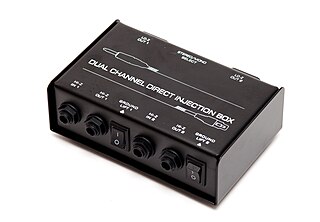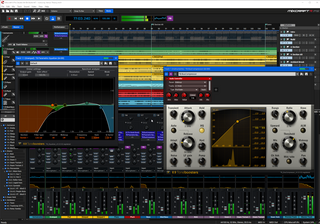Related Research Articles

A mixing console or mixing desk is an electronic device for mixing audio signals, used in sound recording and reproduction and sound reinforcement systems. Inputs to the console include microphones, signals from electric or electronic instruments, or recorded sounds. Mixers may control analog or digital signals. The modified signals are summed to produce the combined output signals, which can then be broadcast, amplified through a sound reinforcement system or recorded.

A phone connector, also known as phone jack, audio jack, headphone jack or jack plug, is a family of electrical connectors typically used for analog audio signals. The standard is that a plug will connect with a jack.

A DI unit is an electronic device typically used in recording studios and in sound reinforcement systems to connect a high-output impedance, line level, unbalanced output signal to a low-impedance, microphone level, balanced input, usually via an XLR connector and XLR cable. DIs are frequently used to connect an electric guitar or electric bass to a mixing console's microphone input jack. The DI performs level matching, balancing, and either active buffering or passive impedance matching/impedance bridging to minimize unwanted noise, distortion, and ground loops. DI units are typically metal boxes with input and output jacks and, for more expensive units, “ground lift” and attenuator switches.

GarageBand is a line of digital audio workstations for macOS, iPadOS, and iOS devices that allows users to create music or podcasts. GarageBand is developed by Apple for macOS, and was once part of the iLife software suite, along with iMovie and iDVD. Its music and podcast creation system enables users to create multiple tracks with pre-made MIDI keyboards, pre-made loops, an array of various instrumental effects, and voice recordings.

Logic Pro is a digital audio workstation (DAW) and MIDI sequencer software application for the macOS platform. It was originally created in the early 1990s as Notator Logic, or Logic, by German software developer C-Lab which later went by Emagic. American technology company Apple acquired Emagic in 2002 and renamed Logic to Logic Pro. It is the second most popular DAW – after Ableton Live – according to a survey conducted in 2015.
The DTX range consists of electronic drum kits and percussion controllers manufactured by the Yamaha Corporation. They currently cover all levels from entry-level to mid-range. DTX kits use sampling for their sounds, so each kit has built-in digital recordings of real drums and cymbals. When the drum or cymbal pads are hit, the digital recordings are played back to replicate what is being played. On all kits, the sounds are editable – the pitch can be made higher or lower (tuned) and many other features. The higher the range of the DTX, the more functions there are editable.
A voice-user interface (VUI) makes spoken human interaction with computers possible, using speech recognition to understand spoken commands and answer questions, and typically text to speech to play a reply. A voice command device (VCD) is a device controlled with a voice user interface.

Mixcraft is a multitrack recording application for Windows. This music recording software functions as a digital audio workstation, MIDI sequencer, virtual instrument host, non-linear video arranger, and music loop recording program.

djay is a digital music mixing software program for Mac OS X, Microsoft Windows, iPad, iPhone, and iPod Touch created by the German company algoriddim. It allows playback and mixing of digital audio files with a user interface that tries to simulate the concept of "two turntables and a microphone" on a computer. Before the commercial release in November 2007, djay had initially been released as freeware in June 2006. In December 2010 the software was also released for the iPad, and subsequently for iPhone and iPod Touch in March 2011.

MainStage is a music application developed by Apple Inc. designed for use in live performance.

iTunes Remote is a software application developed by Apple Inc. for iOS devices that allows for remote control of Apple TV or iTunes library in an area with Wi-Fi connectivity using the proprietary Digital Audio Control Protocol (DACP). It is currently available as a free download from the App Store for iOS devices such as iPhone, iPod Touch, iPad, and Apple Watch.
The following outline of Apple Inc. is a topical guide to the consumer electronics, software, retail stores, corporate acquisitions, timeline, and personnel under the purview of the American multinational corporation Apple Inc. The company's best-known hardware products are the Macintosh, the iPod, the iPhone, and the iPad. Its best-known software includes the macOS and iOS operating systems, and the iTunes media browser. As of March 2014, Apple has 425 retail stores in 16 countries, and an online store.

CarPlay is an Apple standard that enables a car radio or head unit to be a display and a controller for an iOS device. It is available on all iPhone models beginning with iPhone 5 running iOS 7.1 or later.
The Samsung Galaxy Express 2 (SM-G3815) is a smartphone made by Samsung which was launched in October 2013 featuring a similar design and specifications of the Samsung Galaxy S4 Mini but with a bigger 4.5 inch screen and different cameras.

HomeKit is a software framework developed by Apple Inc., made available in iOS and iPadOS that lets users configure, communicate with and control smart-home appliances using Apple devices. It provides users with a way to automatically discover such devices and configure them. By designing rooms, items, and actions in HomeKit, users can enable automatic actions in the home through a simple voice command to Siri or through the Home app. With HomeKit, developers are able to create complex applications in order to manage accessories at a high level. HomeKit is simply a communication protocol, which integrates and operates several types of accessories within the home.

The iPad Mini 3 is the third-generation iPad Mini tablet computer designed, developed and marketed by Apple Inc. It was announced alongside the iPad Air 2 on October 16, 2014 and released on October 22. It uses primarily the same design and hardware as that of its predecessor, the iPad Mini 2. Its new features are the addition of the Touch ID sensor compatible with Apple Pay, differing storage sizes and being available in a gold color, as well as the previous colors.

Bragi is a German technology company headquartered in Munich, Germany, that designs, develops and sells wireless smart earphones; the Bragi OS, the operating system for next-generation computing platforms; and the Bragi App for smartphones.

iOS 13 is the thirteenth major release of the iOS mobile operating system developed by Apple Inc. for their iPhone, iPod Touch, and HomePod lines. The successor to iOS 12 on those devices, it was announced at the company's Worldwide Developers Conference (WWDC) on June 3, 2019, and released on September 19, 2019. It was succeeded by iOS 14, released on September 16, 2020.

Pre-installed iOS apps, referred to in the App Store as 'Built-In Apps', are a suite of mobile applications developed by Apple Inc. which are bundled with iOS and installed by default or through a system update. Many of the default apps found on iOS have counterparts on Apple's other operating systems macOS, iPadOS, watchOS, and tvOS, which are often modified versions of or similar to the iOS application. As each app is integrated into the operating system itself, they often feature greater support for system features than third-party alternatives and are quick to adapt new features of iOS.
Hardware of the iPhone is designed by Apple Inc., who determines internal systems, designs, and prices. iPhones contain many hardware elements in its specifications. Apple directly sub-contracts hardware production to external OEM companies, maintaining a high degree of control over the end product.
References
- ↑ "Pro Audio Software Enters the iPad Arena". Prosoundnews.com. Retrieved 26 September 2010.
- ↑ "StudioMini ♬ Recording Studio Mini". Macworld - AppGuide. Retrieved 26 September 2010.
- ↑ "iPadinCanada Review: StudioMini XL For The Ipad".